Two newly described sea stars named in honor of ocean explorers, including NOAA’s Kelley Suhre
In a new journal article, Christopher L. Mah describes two species and a genus of sea star previously unknown to science. Mah, a research associate with the Smithsonian’s National Museum of Natural History and frequent participant in NOAA Ocean Exploration’s live-streamed remotely operated vehicle (ROV) dives, named the sea stars in honor of two women in the ocean exploration field: marine biologist Rhian Waller and NOAA Ocean Exploration’s own Kelley Suhre. Mah’s research was based on data collected during multiple NOAA Ship Okeanos Explorer expeditions from 2014-2022 and published in the scientific journal Zootaxa. The publication also highlights observations of two other potentially undescribed sea star species and details in situ behavioral observations, providing additional insight into the presence, ecology, and lifeways of these deep-sea creatures.

Bathyceramaster kelliottae, a new sea star species named after NOAA Ocean Exploration’s Kelley Suhre, as seen during Dive 5 of the Windows to the Deep 2021: Southeast ROV and Mapping expedition. The sea star was seen at a depth of 1,386 meters (~4,547 feet). Image courtesy of NOAA Ocean Exploration, Windows to the Deep 2021. Download largest version (1.25 MB).
Every time a remotely operated vehicle makes its way to the deep sea, there’s a good chance of encountering a species as-of-yet undescribed by science. After all, it’s thought that the majority of organisms that call the ocean home have yet to be classified. Given the sheer abundance of life in the deep sea — not to mention the geology and underwater cultural heritage sites — the utility of NOAA Ocean Exploration expeditions is compounded by the effort and knowledge of experts from a wide range of scientific disciplines from around the world. At each stage of an expedition, from the planning process to real-time dives, these experts ensure that exploration efforts reflect the scientific interests of a diverse field.
And while keen-eyed scientists watching a dive in real time may have an immediate hunch that an organism might represent a species new to science, it can often take years of careful analysis before such a claim is published. Far less visible than the moments of awe that frequently capture public imagination, the majority of scientific work generated from an expedition takes place in the months and years after an expedition comes to an end. It’s at this time that scientists and researchers like Mah can take the publicly available data collected during an expedition, including biological samples and imagery, and make meaning of it.
In the case of the newly discovered sea stars, this meant close study of the physical features and defining characteristics of the organisms, comparing them to known species. An accomplished taxonomist, this isn’t the first time that Mah’s contributions to science have contained a nod to the people and places that facilitate his work, highlighting the multifaceted nature of ocean exploration and the importance of collaboration within the field. “Honoring both of these excellent scientists for their contributions was a no-brainer,” said Mah. Waller, whose research focuses on the reproductive ecology of deep-sea organisms, primarily cold-water corals, collected the specimen now known as Rhianastra isosceles, representing both a new genus and species. Suhre, deputy chief of NOAA Ocean Exploration’s Expeditions and Exploration division has been “an endless source of inspiration and… powerful resource for scientists” in her work with the office, and is the namesake of the new species Bathyceramaster kelliottae. These species and others still undescribed highlight the overwhelming diversity in the deep sea “that we are always catching up to document,” according to Mah.
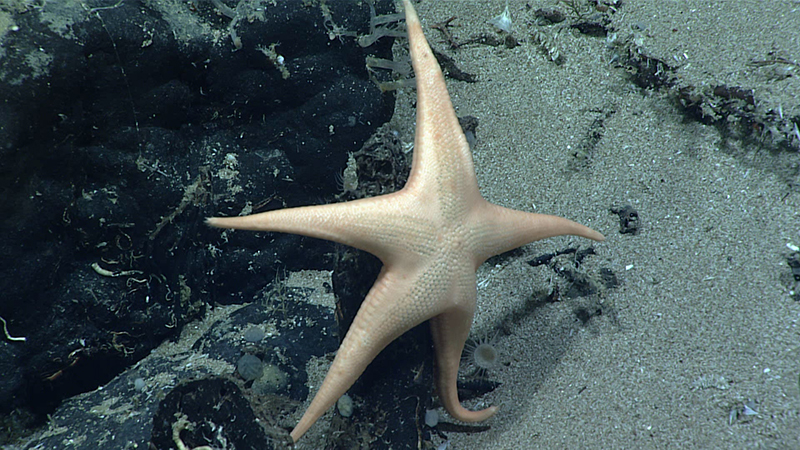
Rhianastra isoceles is a newly described genus and species named after scientist Rhian Waller. Its triangular arms inspired its genus name “isosceles.” This specimen was seen at a depth of 1,752 meters (5,748 feet) during Dive 4 of the 2021 North Atlantic Stepping Stones: New England and Corner Rise Seamounts expedition. Image courtesy of NOAA Ocean Exploration, 2021 North Atlantic Stepping Stones: New England and Corner Rise Seamounts. Download largest version (1.12 MB).
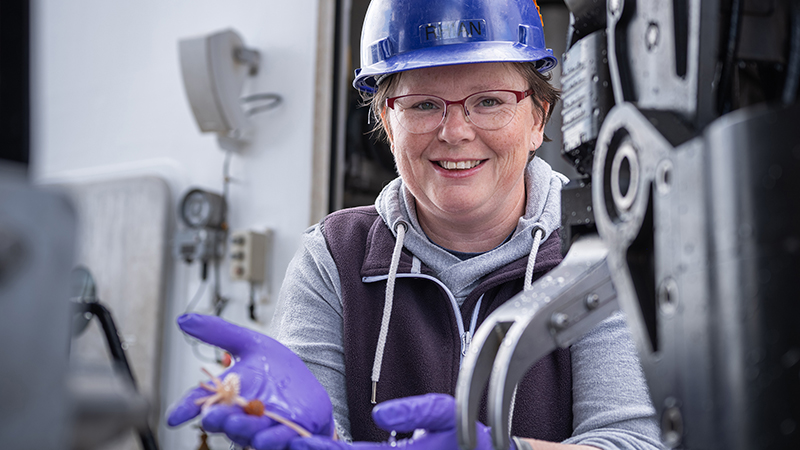
Rhian Waller is seen holding a biological sample during an expedition aboard NOAA Ship Okeanos Explorer. Image courtesy of Art Howard, Global Foundation for Ocean Exploration. Download largest version (2.87 MB).
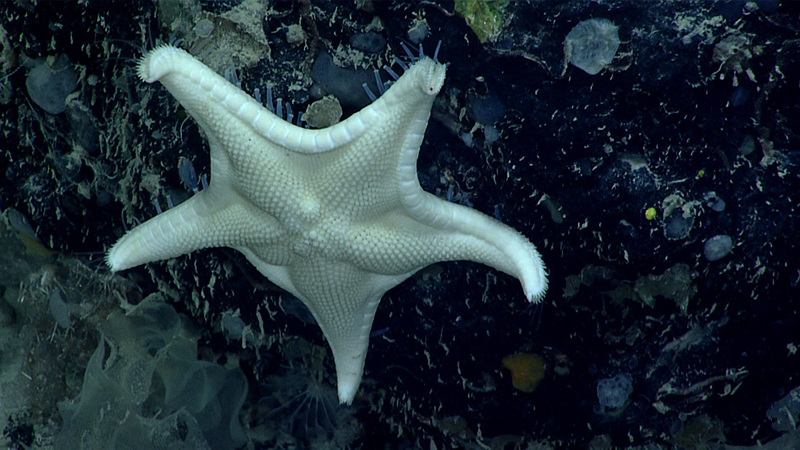
A close up of Bathyceramaster kelliottae as seen during Dive 5 of the Windows to the Deep 2021: Southeast ROV and Mapping expedition. The sea star was seen at a depth of 1,386 meters (~4,547 feet). Image courtesy of NOAA Ocean Exploration, Windows to the Deep 2021. Download largest version (1 MB).
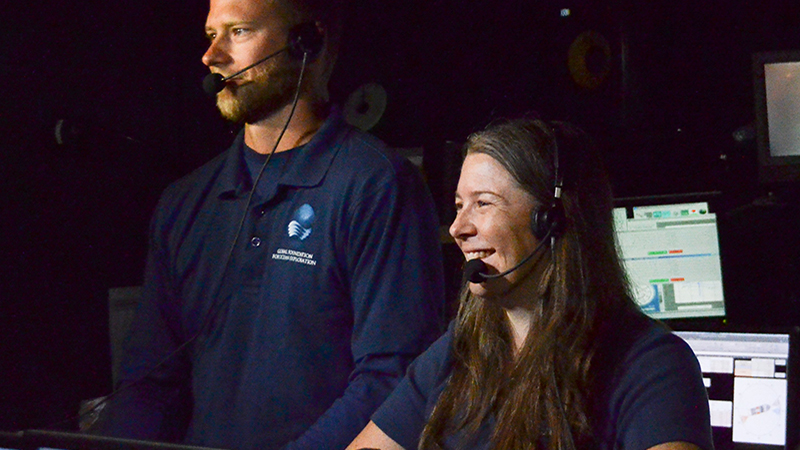
Kelley Suhre (right) and a fellow explorer conduct a live interaction with visitors at the Exploratorium in San Francisco, California, while aboard NOAA Ship Okeanos Explorer. Image courtesy of the NOAA Ocean Exploration, 2017 Laulima O Ka Moana. Download largest version (1.33 MB).
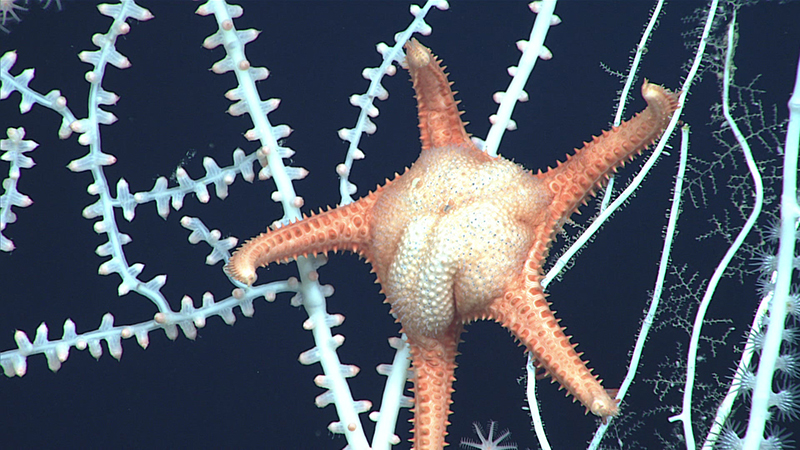
This sea star, potentially an undescribed species in the genus Atheraster, was imaged during a NOAA Ocean Exploration but not collected. For Mah, it “highlights the overwhelming diversity in the deep sea that we are always catching up to document.” It was seen during Dive 3 of the 2021 North Atlantic Stepping Stones: New England and Corner Rise Seamounts expedition at a depth of 2,105 meters (6,906 feet). Image courtesy of NOAA Ocean Exploration, 2021 North Atlantic Stepping Stones: New England and Corner Rise Seamounts. Download largest version (950 KB).
Access the full article online (subscription/fee access)
Mah, C.L. (2024). Two New Taxa of Goniasteridae (Asteroidea, Echinodermata) and Noteworthy of Deep-Sea Asteroidea by the NOAA Ship Okeanos Explorer in the North and Tropical Atlantic. Zootaxa 5432 (4): 461-508. https://doi.org/10.11646/zootaxa.5432.4.2
Published April 16, 2024